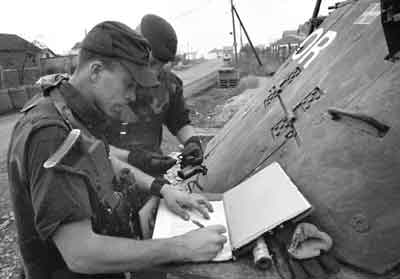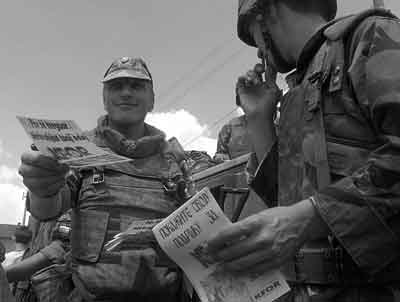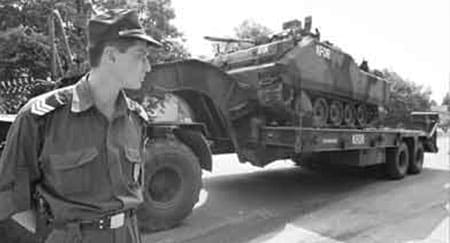At the Washington summit last year, allied leaders set out their vision of an alliance with new missions, new members, new partnerships, and a commitment to strengthen its defence capabilities. The new Strategic Concept recognised partnership as the vision guiding the evolution of NATOs relationship with its Partners. one of the fundamental security tasks of the alliance, and most summit initiatives had a partnership dimension. Drawing together the different elements of the Partnership for Peace that were strengthened at the summit, this article highlights.

US infantry soldiers arrive at Skopje airport on 10 June 1999, ready to deploy to Kosovo as part of KFOR. The former Yugoslav Republic of Macedonia (1) gave staunch support to the allies from the start of the Kosovo crisis. NATO troops were stationed there during the winter of 1998/99, on standby to extract OSCE cease-fire monitors if needed. Assistance was provided to hundreds of thousands of Kosovar refugees. Access to its air space and territory facilitated the conduct of the air campaign and the deployment of KFOR. (Belga photo - 10Kb)
The basic building blocks for the success of the Partnership for Peace (PfP) programme were laid at the Brussels summit in 1994. The PfP Framework Document outlined how the Partnership supported both alliance strategy (as set out in the alliances 1991 Strategic Concept) and the enlargement process. Specific objectives for practical military and defence-related cooperation were defined and the character and scope of the Partnership itself were determined.
From the outset, PfP invested in people: in the armed forces which might be deployed in future military operations, and in the defence community officials who would shape and participate in decision-making processes, aimed at promoting Euro-Atlantic security and stability. Through education, training and exercises, NATO exported its way of doing business to countries interested in developing closer ties to the alliance even to those that did not necessarily hope for eventual membership.
PfP has exceeded every expectation. Today, it has extended its cooperation to 25 non-NATO countries and is fostering contacts in the defence support com-munity, as well as in civil-emergency, military and defence establishments. All are shareholders in this enterprise and have helped make the Partnership a permanent fixture of Euro-Atlantic security.
The first tangible benefits from the investment in PfP were seen in the NATO-led operations in Bosnia and Herzegovina, where the Partnership made it easier for troops from Partner countries to be deployed along-side allied forces as part of IFOR and SFOR. This positive experience was reflected in the strengthening of the Partnership at the Madrid Summit in 1997 and led to the more operational focus given to the Partnership since then. As we are seeing again today in Kosovo, the reality is that future NATO-led operations will almost certainly involve Partners.
An integral part of alliance strategy
As a measure of PfPs success, the updated Strategic Concept agreed at the Washington summit included partnership among NATOs fundamental security tasks, along with security, consultation, deter-rence and defence, and crisis management. Moreover, nearly all the summit initiatives had a Partnership dimension, be it the Membership Action Plan (MAP), the Defence Capabilities Initiative, the South East Europe Initiative, the Political-Military Framework for NATO-led PfP Operations, or the Enhanced and More Operational Partnership. (2)
The updated Strategic Concept NATOs mission statement at the start of the new century reflects the profound geopolitical changes of the last decade and recognises the increased importance of NATOs Partners in facing future security challenges. The allies remain committed to securing the military capabilities needed to be able to respond on their own to the full range of foreseeable circumstances. But they have also chosen to focus more on developing cooperation with non-members that share alliance objectives, and on engaging them politically and militarily in efforts to promote Euro-Atlantic security.
This strategy paid dividends during the Kosovo crisis. Partner countries exhibited a common purpose and shared values in their approach to the conflict and their political support for NATOs operation reinforced its legitimacy. Countries neighbouring the Federal Republic of Yugoslavia also lent practical support to the allies, including access to their air space. The troop contributions from Partner countries are vital to sustain the long-term deployment of forces in the simultaneous, multinational SFOR and KFOR operations.
A capability-oriented approach

A Bulgarian police officer directs traffic in front of a Turkish military convoy, which was allowed to pass through Bulgaria on 3 July 1999 on the way to join KFOR. (Belga photo - 10Kb)
The Balkan operations demonstrated the validity of NATOs strategy of associating Partners to allied military efforts. They also pointed to the need to address deficiencies in defence capabilities and to plan and prepare for future multinational operations, which will require greater interoperability and multinationality at lower levels of command.
Building on past military cooperation, the Washington summit provided scope for strengthening the ability of Partners and allies to deploy together in future crisis response operations through the Operational Capabilities Concept (OCC). Its implementation will complement allied efforts to boost capa-bilities in the key areas identified in the Defence Capabilities Initiative, and will make it easier to project what forces could be called on in future to mount and sustain NATO-led PfP operations.
Working relationships between Partner and alliance headquarters, staffs and formations will be strengthened to prepare for future combined operations. The PfP Training and Education Enhancement programme, which was also approved at the summit, will help make the Partnership more operational by better targeting investments in human resources.
The Planning and Review Process is being expanded and adapted to help improve the interoperability and capabilities of the forces available for PfP activities. At the operational level, the forces and capabilities available in principle for NATO-led PfP operations are identified and goals are set for defence planning purposes. At the political level, Partners have since 1999 been given the opportunity to work with the allies at the ministerial level to give strategic direction to the future development of their capabilities.
A political overture

Swedish KFOR soldiers register a pistol that was confiscated from an ethnic Albanian before entered the Serb- dominated village of Granica in central Kosovo 12 December 1999. (Belga photo - 10Kb).
With the allies seeking to associate Partner countries to their future operations, Partners are calling for a more active role for themselves in formulating the political guidance for such operations and in overseeing them. The Political-Military Framework for NATO-led PfP operations adopted in Washington responded by setting out the principles and methods for involving Partner countries in political consultation and decision-making, as well as in operational plan-ning and command arrangements.
Troop contributing Partners already regularly consult with the 19 allies at the political and military levels on matters relating to SFOR and KFOR. These meetings provide an important political dimension to the close military cooperation taking place on the ground. In light of the Kosovo crisis, the mechanisms for consultation and decision-making with Partners will be improved in line with the Political-Military Framework, so that they are more effective under the time pressure of crisis response situations.
A regional focus for crisis management

A Russian KFOR soldier (left) and his US comrades distribute leaflets in Albanian and Serbian saying "Show your sup-port for KFOR give a thumbs up for peace", during a joint operation in villages with mixed populations some 30 km east of Pristina 16 July 1999. (Belga photo - 10Kb)
In southeastern Europe, PfP is making an increasingly important contribution to managing the crisis, building confidence, and ultimately preventing renewed conflict. The Partnership is one of the international communitys key tools in its multilateral efforts to support peace and stability, part of a comprehensive strategy to secure long-term, realistic solutions. Its strength lies in the flexibility and range of practical measures, which can be tailored to the circumstances and requirements of countries within a particular region.
The Partnership has yet to realise its full potential in the areas of crisis management and conflict prevention. But already the operational Partnership is contributing to the management of crises by making it easier to deploy and sustain operations during conflicts; through targeted security cooperation programmes once conflicts have ended; and through confidence-building measures and consultation mechanisms to prevent the break-out or resumption of conflicts.
A functional focus for membership preparations
PfP also complements the Membership Action Plan, which helps countries hoping eventually to join the alliance to prepare their candidacies. In the defence and military field, the MAP relies greatly on PfP, which is seen as an essential training ground where interested Partner countries can prepare for the responsibilities and obligations of common security and collective defence, and target their individual PfP programmes and planning accordingly. The MAPs focus on better feedback and assessment tools will in turn strengthen the Partnership.
Partnership: a two-way street
Partnership is now integral to NATOs missions and activities. Its tools and working methods provide policy-makers, who want to focus on specific issues or regions, with options for generating support among interested countries to increase the scope for action and quickly translate ideas into practice. The Partnership is a dynamic one. It has prompted numerous initiatives aimed at contributing to Euro-Atlantic security and stability and will evolve as NATO allies and Partners explore more ways of deepening their cooperation.
As part of NATOs new fundamental security tasks, Partnership will promote increased interoperability and multinationality, in order to better prepare for joint action, as well as increased involvement in decision-making for troop contributors. Partnership is a two-way street, but it ultimately offers policy-makers the possibility to reach win-win solutions, and transform challenges into opportunities.

